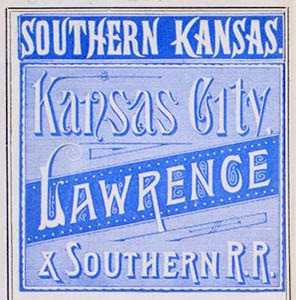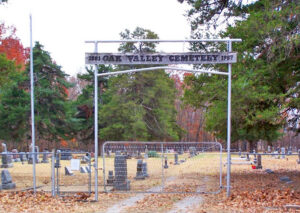Oak Valley, Kansas, is an extinct town in Elk County.
The land upon which Oak Valley would be established was initially entered as a claim by Daniel Moser. In 1871, John Johnson purchased it. It was beautifully situated at the confluence of Hickory Creek and the Elk River in a forest composed mostly of oak trees, from which it derived its name.
A post office called Oak Valley was established on December 27, 1875, and John Johnson was commissioned postmaster, who kept the office at his residence.
The completion of the Kansas City, Lawrence & Southern Railroad was made in August 1879 and was the cause of the establishment of the town. The same month, John Johnson built a two-story flouring mill that measured 28×40 feet and contained two runs of buhrs, having a grinding capacity of 25 barrels of flour per day. The power was derived from Elk River via a turbine waterwheel. The depot building was erected in September 1879, and John Johnson laid the town out the same month.
The first structure erected on the site was a residence built by John Johnson, which was followed by the erection of a storeroom by M. Donovan, in which he opened a stock of general merchandise. The next business house was built by H. Shoemaker, which he afterward sold to John Johnson and George E. Ott used it for a drug store. In April 1880, the post office was moved from John Johnson’s home to the drug store. After about a year, it again changed hands, being purchased by R.M. Smith and used by B.F. Clark for a general store. A blacksmith shop was started in May 1880 by H. Shoemaker, who, in October of the next year, sold it out to J. P. Molton.
In March 1881, N.B. Bryant and M.Davis put up a storehouse and engaged in the sale of general merchandise, and in September of the same year, G.D. Berger established a similar business in a building erected for that purpose.
The organization of a district school for the town and vicinity was effected in April 1882, and a school building was erected at a cost of $800, for the payment of which the district issued bonds to that amount.
The first religious services were held on July 23, 1882, by Reverend Callison, the Presiding Elder, with the meeting taking place in the school building.
By that time, the town was called home to about 125 people. Its trade was supported and supplied mainly by settlers from the Upper Duck, Salt, and East Painterhood Creeks.
No circumstance presents itself from which to foretell favorably for the town’s future. Unfortunately, the character of its surroundings was rather against this. The total unfitness of much of the land surrounding the place for agricultural purposes and the consequent limited area of tillable land were the chief obstacles. However, it was predicted that the town would continue to be a fine trading point and depot for purchasing domestic and farm supplies.
By 1910, Oak Valley was the Atchison, Topeka & Santa Fe Railroad. At that time, all the main lines of trade were represented. It also had express and telegraph offices, a money order post office, and a population of 149.
The post office closed on February 15, 1954.
This old townsite is located along the U.S. Route 160 highway between Longton and Elk City. There are still a few homes and buildings in the area.
©Kathy Alexander/Legends of Kansas, December 2023.
Also See:
Sources:
Blackmar, Frank W.; Kansas: A Cyclopedia of State History, Vol I; Standard Publishing Company, Chicago, IL 1912.
Cutler, William G; History of Kansas; A. T. Andreas, Chicago, IL, 1883.
Elk County Facebook
Wikipedia




